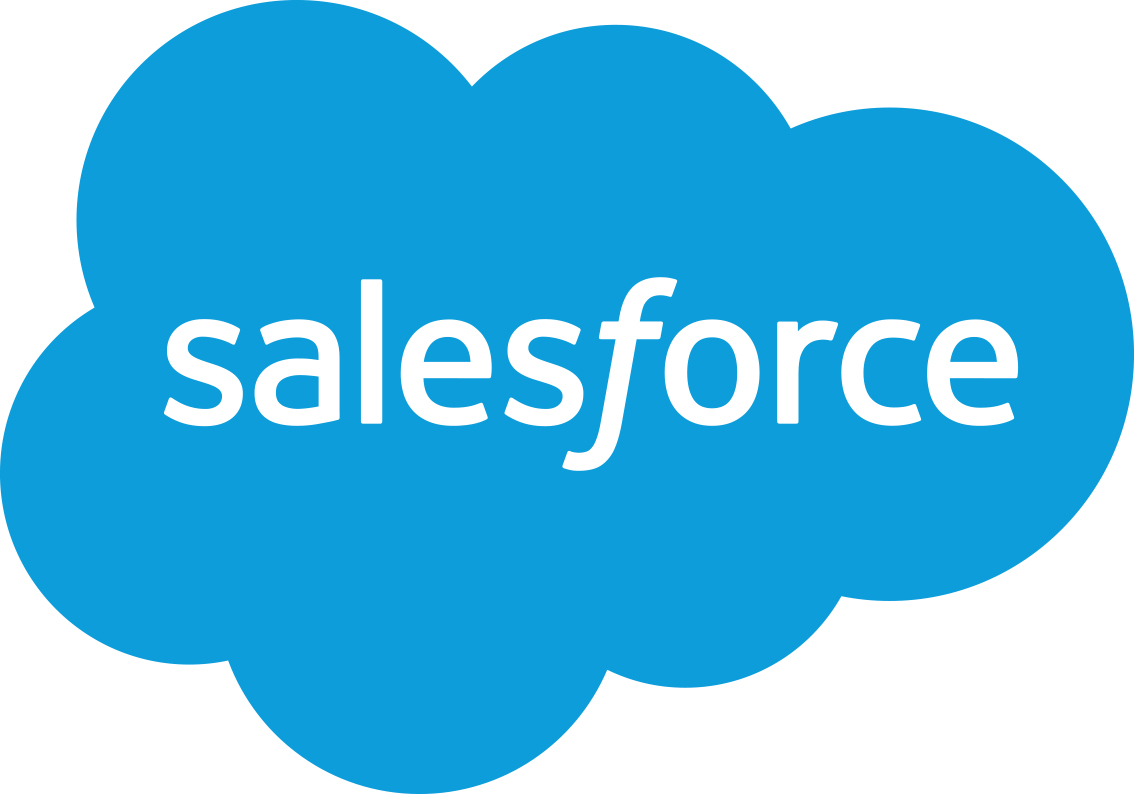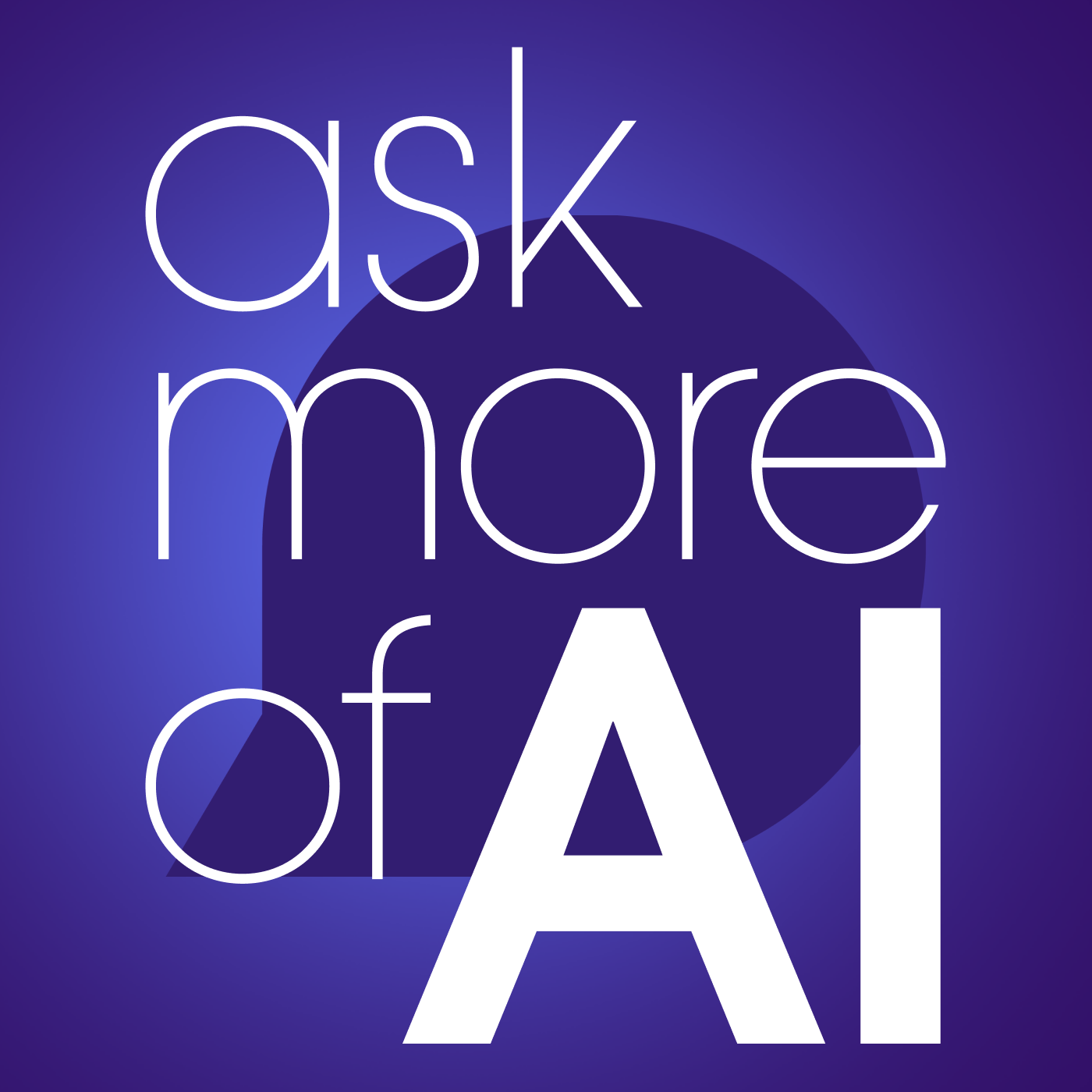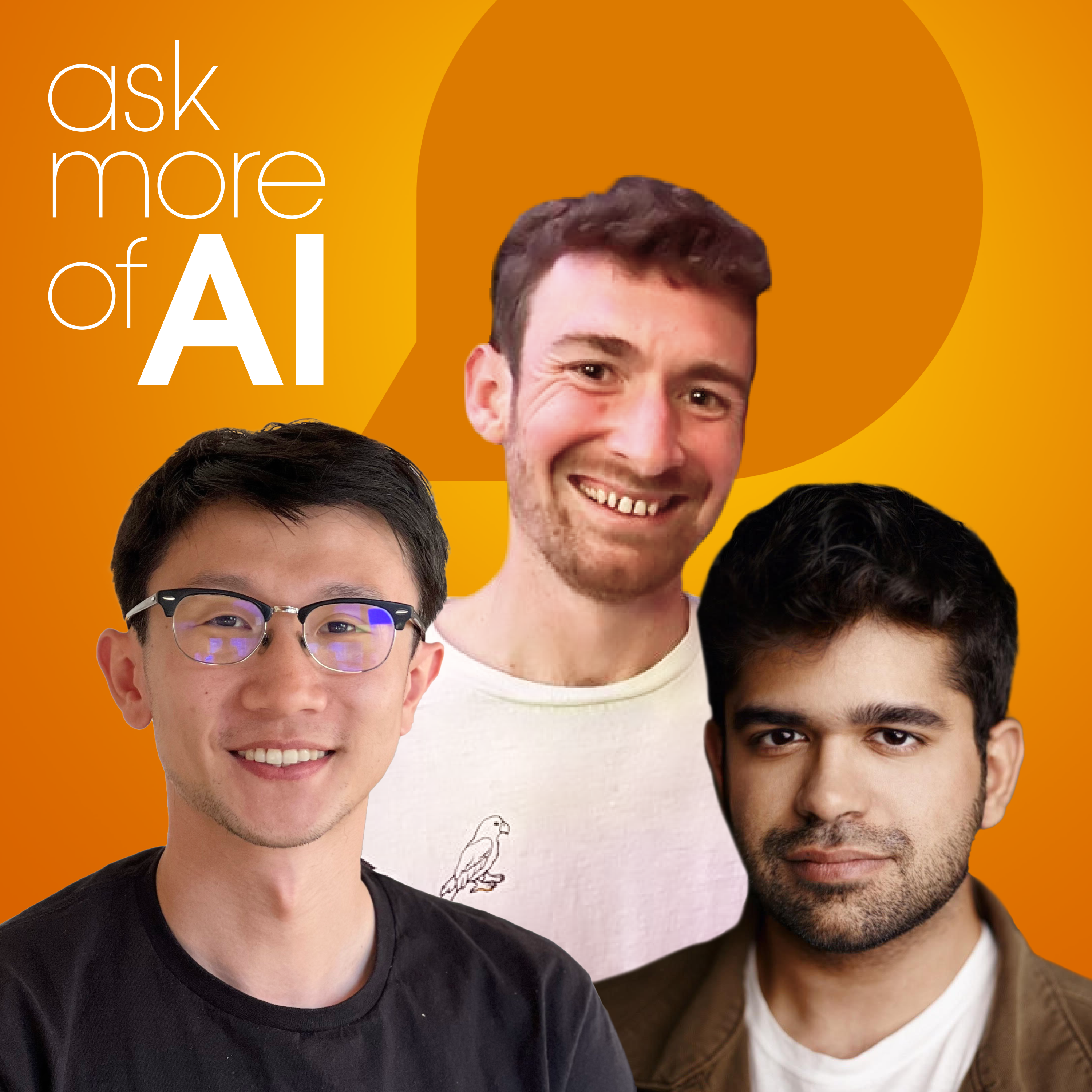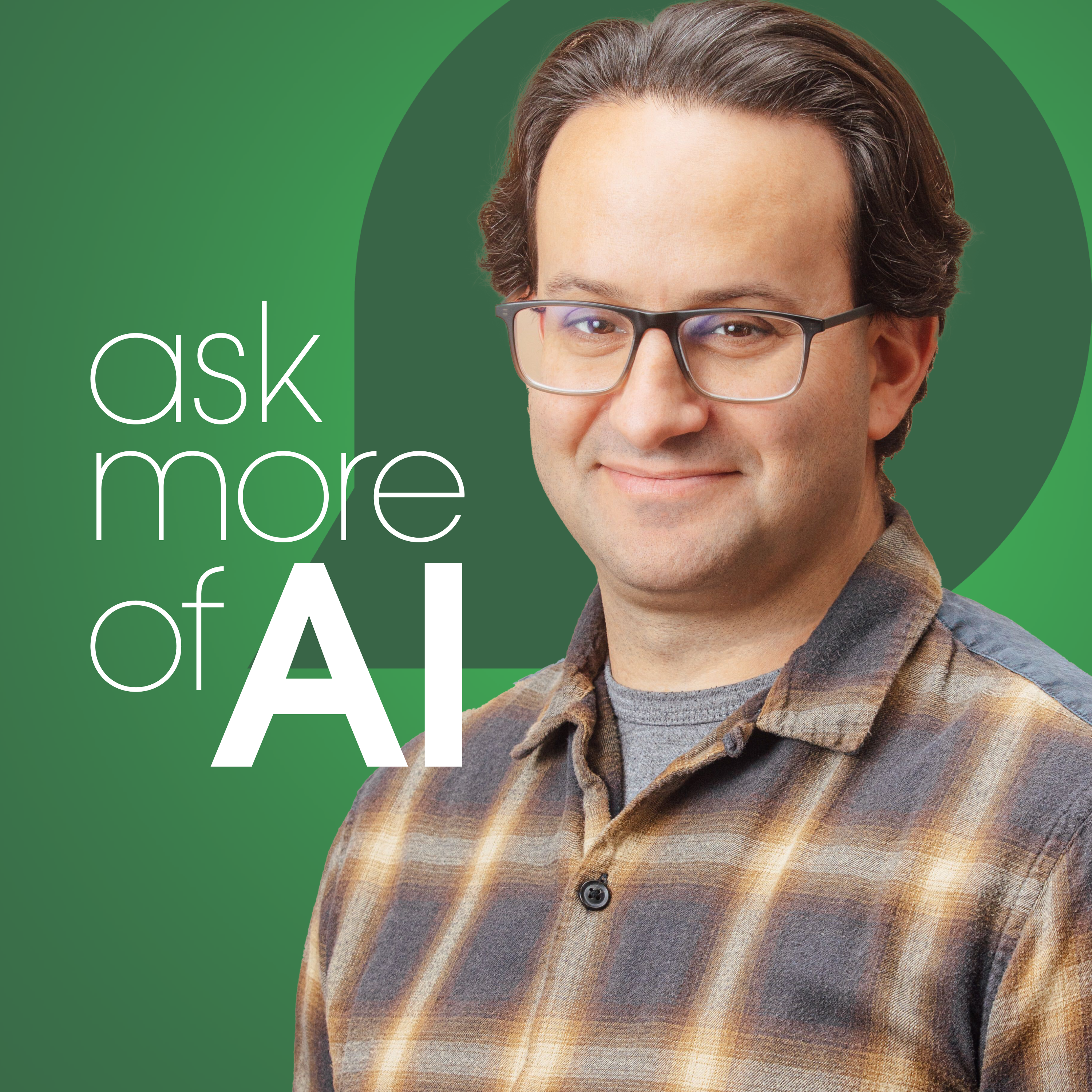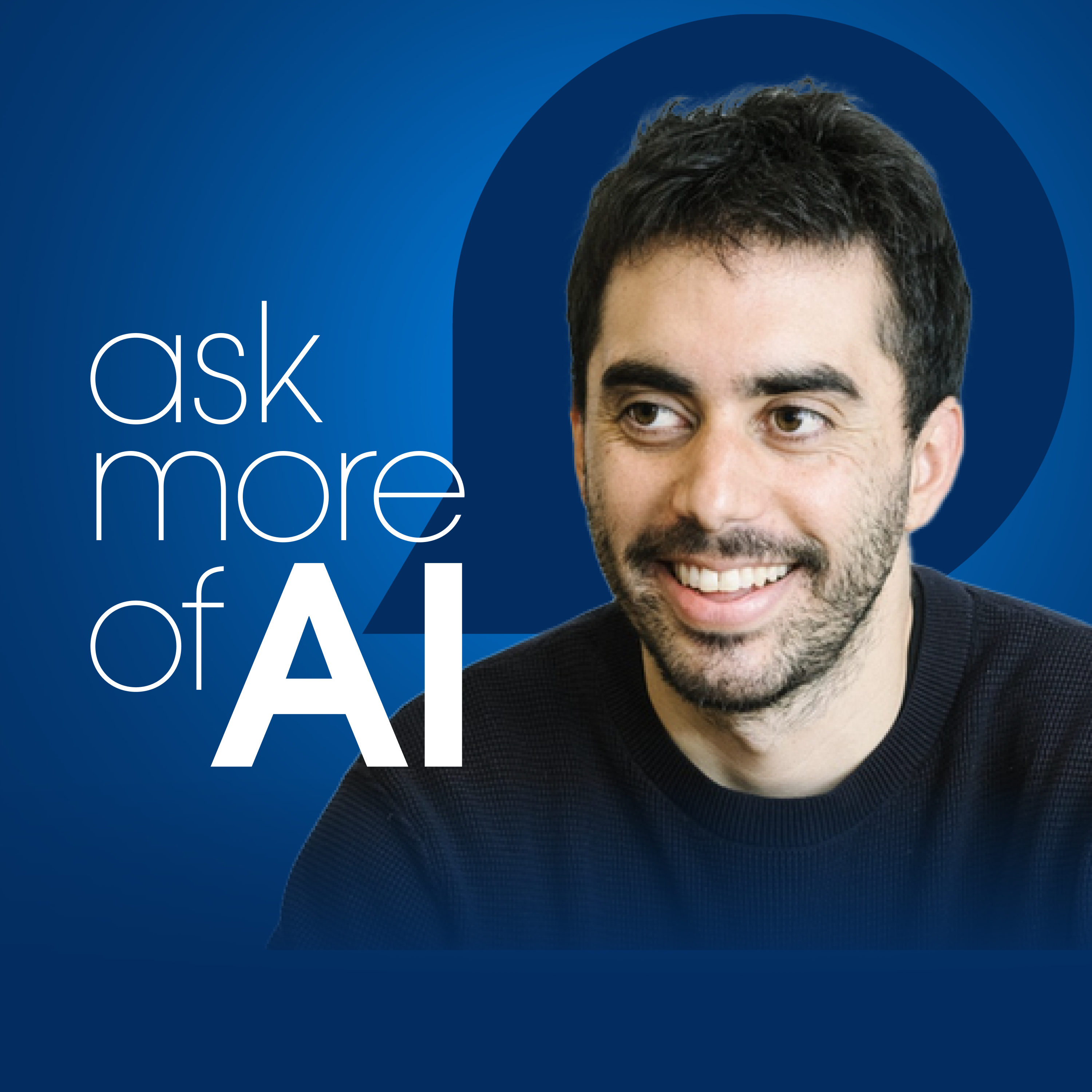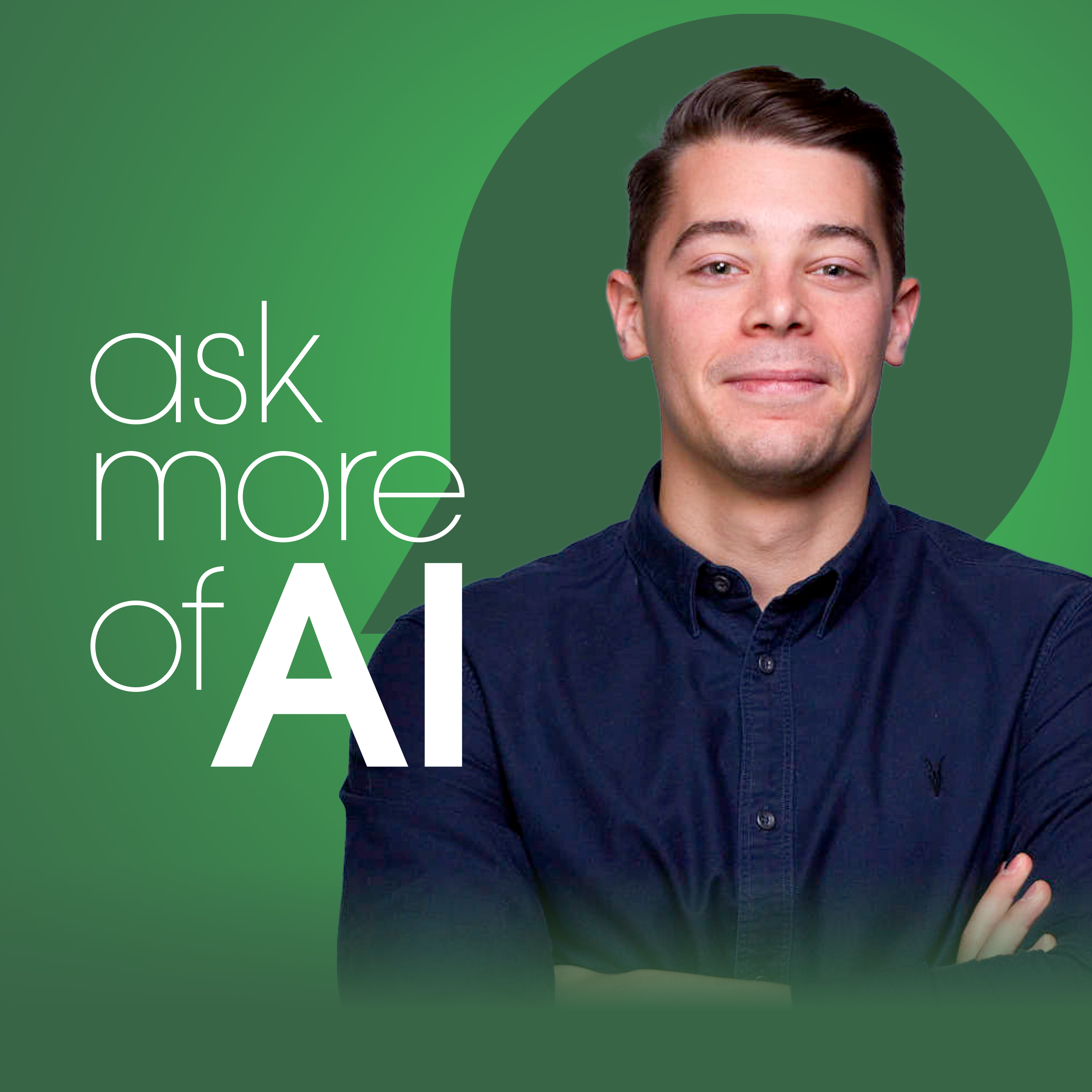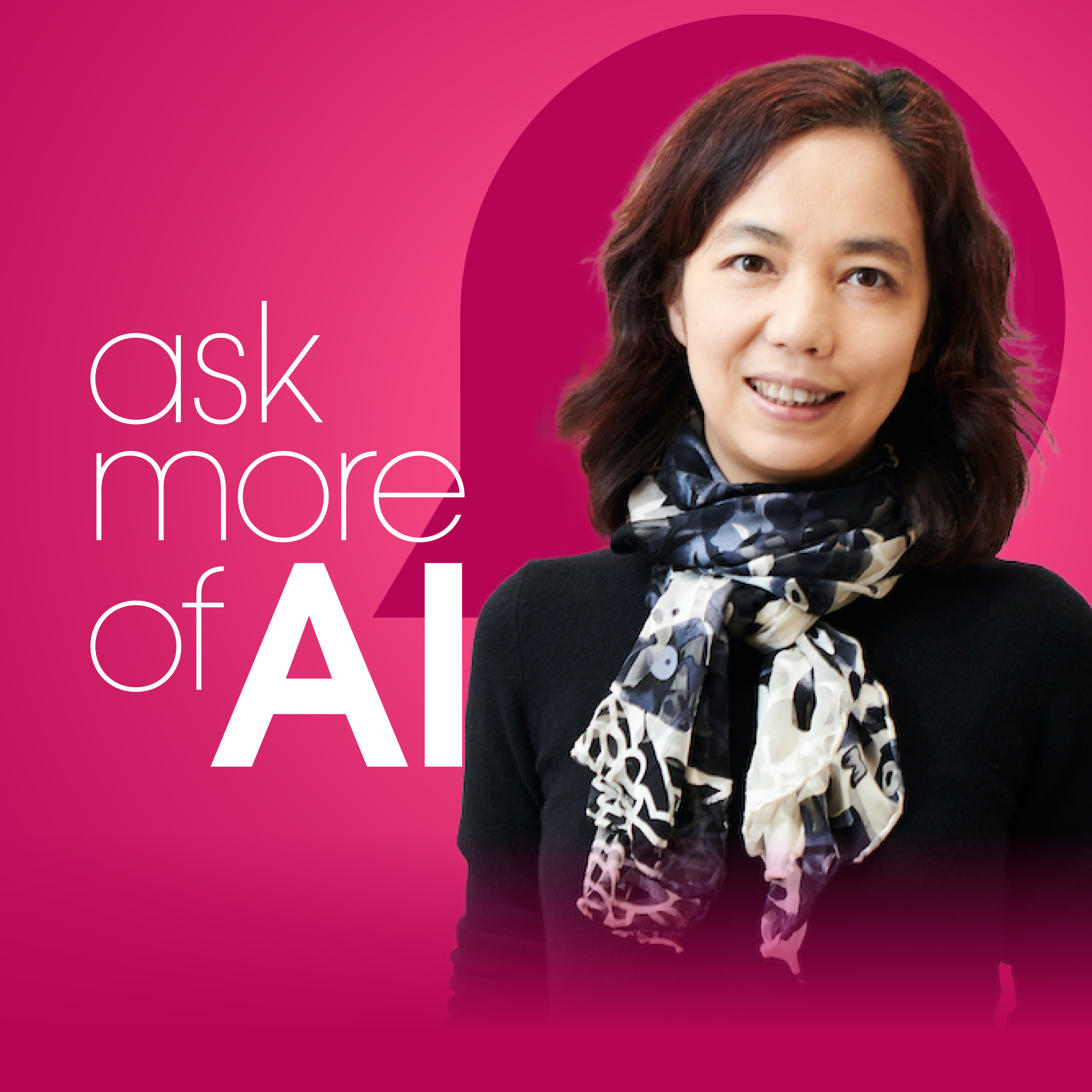The AI + Data Copilot Revolution feat. Gucci and SiriusXM
- 0.5
- 1
- 1.25
- 1.5
- 1.75
- 2
Clara Shih: We're democratizing who has that ability to build AI applications in this exciting era. And of course, we've brought generative AI into every single one of our clouds, from sales, service, marketing, commerce, developers and more. Welcome to Ask More of AI, a podcast looking at the intersection of AI in business. I'm Clara Shih, CEO of Salesforce AI. And this week I wanted to share with you our Dreamforce AI Plus Data keynote showcasing some of the amazing work that our team is doing. I hope you enjoy it.
Speaker 2: Please welcome CEO Salesforce AI, Clara Shih.
Clara Shih: Welcome to Dreamforce. Welcome to the largest AI event in the world. Now, there's no question, we are in an AI and data revolution, which means that we're in a customer revolution and a business revolution. But it's not as simple as taking all of your data and training a model with it. There's data security, there's access permissions, there's sharing models that we have to honor. These are important concepts, new risks, new challenges, new concerns that we have to figure out together, and that's why I'm so thrilled about our new platform. And of course, these challenges, they span not only data security and data privacy and data governance, but also new ethical concerns, new questions because these large language models, they're trained on the corpus of data from the internet. And unfortunately, the internet, there's hate speech, there's bias, there's toxicity. And so we have to pioneer new methods, new technologies, new ways to safeguard against these risks. It's very similar to 25 years ago when the internet revolution took place. We had to pioneer new ways to safely and securely store your customer data in the cloud. We take it for granted now, but two and a half decades ago, that was a radical concept and we had to invent it together. We had to educate our companies together on how to do it in a trusted way. Trust is the number one value of Salesforce, and we're bringing that same mindset, that same innovation, that same approach. All of our engineers, our researchers, our ethics team, our product managers, our product designers, we're bringing all of that together to pioneer a new way to deliver trusted generative AI to all of our customers and partners. And that's why we have the Einstein 1 Platform that we're so thrilled to announce this week. The Einstein 1 Platform now has Data Cloud and our Einstein Trust Layer built natively into the platform. And Data Cloud can bring in all of your Customer 360 data from Sales cloud, Marketing cloud, Service cloud, Commerce cloud, Slack, and even across your entire enterprise, both through real time as well as batch data through MuleSoft Anypoint Connectors, you'll hear more about this in a moment, bringing all of this into your native Salesforce platform so that you can treat all of your data across your enterprise like a Salesforce object. What does that mean? It means that you can take any of this data and you can report on it, you can visualize it and explore it with Tableau. You can build flows that trigger off of that data. You can use that data for AI to train and fine tune models, to ground your prompts with powerful semantic search, to reduce the risk of hallucination. It means you can do much more to activate the data that you have across your enterprise. That's the power of the Einstein 1 Platform. Now today, we're so excited to talk to you more about these new announcements that are the future of CRM and the future of enterprise AI. First, we'll talk to you about Einstein Copilot, a new conversational interface, a new assistant to help every sales team, service team, marketing team, commerce team, developers and admins, all of the trailblazers out there to really take advantage of generative AI in a trusted, secure way, grounded in your sharing models and all of your enterprise data that Data Cloud has captured. We'll also talk to you about how you can really customize Copilot to be your own, to fit your brand voice, to fit your business needs, to access the workflows that you've built on Salesforce over the last 20 years through Einstein Copilot Studio. And to make all of this possible, of course, is Data Cloud. And we're going to include some free Data Cloud to get you started on your AI journey. So we'll talk about each of these. Now, all of this comes together in our Einstein 1 Platform that sits on top of our hyper force secure, trusted infrastructure. It now includes Data Cloud, again, natively as part of the Einstein 1 Platform. It includes our open model architecture, whether you're choosing one of our curated models that we've vetted for trust and safety, or you've trained and tuned your own predictive and generative models that you want to bring in to Einstein. It includes now our Einstein Trust Layer, data masking toxicity filters, audit trail. We'll show you how all of this works in just a moment. It includes our low code builders. So many of you have been building workflows and applications on our platform for decades now with no code and low code and pro code. Now, you can build AI applications in the same way. We're democratizing who has that ability to build AI applications in this exciting era. And of course, we've brought generative AI into every single one of our clouds from sales, service, marketing, commerce, developers and more, both through buttons and the lightning interface and components, as well as through the new Einstein Copilot conversational assistant. The more context we can give to the models, the less the model will hallucinate. They don't have to make it up because we're giving it the context through semantic search. And it's so exciting to see how Data Cloud is expanding as a data lake, a data warehouse to be able to capture both structured data and unstructured data, and so we're going to hear more about that today. So this is what we're going to cover. We're going to talk about Data Cloud and why it's so essential for powering both predictive AI as well as generative AI. Next, we'll cover in detail what we are doing in AI around Copilot, Copilot studio and the Einstein Trust Layer that makes AI safe, secure, and ethical for businesses. And then last but not least, we're going to hear about how all of these innovations come together to power the next generation of CRM. And along the way you're going to hear from customers, I know many of you are already using Service GPT and Sales GPT, and we love your feedback and we're excited to share with you what we're doing on the basis of that. So first I'd like to bring up who better to talk about unified data than one of the key architects and leaders of this whole Data Cloud area for us. Some know him as Murali Krishnaprasad, some know him as MK, some know him as Muralidhar, some know him in your systems as M. Krishnaprasad. That is the reality of the data in every single one of our companies today. And this is the power of Data Cloud is bringing all of those disparate identities, all of those data silos, unifying and harmonizing into a single unified profile. MK, come on up and tell us about Data Cloud.
MK: Thank you, Clara. I'm like a walk- in unified profile here. I'm happy and excited here to talk about data. And if you remember last year we introduced this product called Genie. Data Cloud was called Genie back then. And we've been hard at work making Data Cloud successful. Why? Because we believe everybody's business strategy, your AI strategy and most importantly, your customer relationship strategy all depends on a solid data foundation. And with Data Cloud, we can really bring all the data that you have together to harmonize and really power all of your experiences, and Data Cloud can scale to tremendous volumes. And we've done some interesting integrations with all the lakes, warehouses and others, and we have seen tremendous success. This is the fastest growing organic product innovation in Salesforce history, and our customers are loving it. If you see Inter, for example, they saw over 20X ROI in all of their campaigns, and F1 is able to turn three X the amount of fan growth and over half a billion fans across the world. And GMI saw huge success in trying to get more people to come to their website and get first party data. But like Clara said, a lot of you wanted to know more. You wanted to try it on and really see it for yourself, which is why we are happy to announce a starter Data Cloud with two Tableau licenses for all of you to enable. So click on that QR code and you'll get all the instructions on how to enable it. We are introducing this new thing called data graphs. What does data graphs do? We saw that big enterprise graph and then with data spaces we created organizational graph. With data graph, what you can do is you can take all the most important things, data that you need for an application or for a prompt and then pre- create it. And with this, you get this one JSON object that you can just use quickly. Let's go back to the demo and see that in action. Right there, see? That is how you create a data graph. So you see that unified individual with all the related sales orders and shopping cart items, maybe let's go out, add some product specifications in there. It's as simple as clicking that, doing product details, you see that. So if you have selected this part of the data graph, we can save and deploy. You know what happens? It basically automatically maintains that graph and it creates a JSON object for that. So you ask for that user, you're going to get back everything they have done. Now, let's write again. So let's go add that data graph, so one thing, that's all you have to do in the prompt. Now, let's go do the playground and generate that prompt. You see what happens there? You see all the details about Andrea is right there embedded. It's about Andrea, what she has done, the marketing, her order history, the product specifications, sales orders, everything in one shot. And you know why this works? Because LLMs are super smart. You don't need to tell them anything. They actually understand what this actually means. Now, let's go do a generate of that and see what happens. Now, you see what happened? The LLM was able to detect that there was an issue with the hiking boots that she tried to order before. So now it's saying, " Look at recall our conversation about stocking our hiking boots," and she had a shipping issue before. She actually downloaded a white paper. So imagine now it feels as if Gabe knows Andrea personally, everything she has done with the business and now he can actually send that email, and Andrea is definitely going to respond positively to that. So let's go back to that email and you'll see that you can now create that prompt because you saved that prompt, you can now draft that same email and it should be right there. That is the power that data can actually bring. So what did we see? We saw data come from different sources, your CRM, your marketing, your bring your own lake with Google and many others. And we were able to quickly harmonize it, normalize it, unify it, create rich graphs with it, and then power these prompts. Now, this looks like a lot. There's a lot coming as you can see very shortly, but there is a lot more coming because what we saw was all structured data. So we are going to soup this up with more unstructured data so you can start doing segments like who had actually had similar case issues like this person, how can I alert someone if they have some negative comment that they're talking about? All of that is something that we are hard working on trying to bring all of that unstructured with your structured and trying to do semantic search on it. Now, enough said about all this stuff. You probably want to know about someone who's actually now used it in practice, and let's hear the experience. For that, I would love to welcome Joe. He's a pioneer in the media industry here. And Joe Inzerillo, Chief Product and Technical Officer. Welcome, Joe.
Joe Inzerillo: Thank you.
MK: Welcome to Dreamforce. So Joe, you've had a long distinguished career and you've seen many interesting revolutions come through, mobile, tech, social and so on. What is different about this generative AI?
Joe Inzerillo: Well, I think I'm really happy that we're past the hype cycle of the computer's going to kill everybody and we're getting to the real brass tacks of it. And I think what you guys have done is really compelling because the combination of the generative AI and the speed at which these models are moving and the capabilities that they have inside of the safety of your environment, but then with the bring your own data lake, you really start to get into this world where you can run models that you've built, you can hybridize them with yours, AI's talking to AIs is the wave of the future. And so I think in the same way that the internet connected people and websites together and everything like that, we're now getting into the era of AIs being able to do the same thing with each other, so it's just a compounding effect that we're seeing. And I think the power of that is really, we're just at the very, very beginning side of it. So just like everybody predicted the internet and mobile and all these things, were going to change the world, AI will as well. It's always going to take a little longer than what we expect when it first comes out, but the effects are already profound.
MK: That's awesome. And Joe has had, just like everyone else in the industry, trying to bring all his data together to make that unified profile and make SiriusXM data powered. So can you explain to us our journey, your challenges and how also Data Cloud helped you with that?
Joe Inzerillo: Yeah. I think we have a very unique business. So for those of us who are not familiar with us, we have a radio service that we're known for in the cars in North America. We own Pandora, we own AdsWizz. We own a bunch of other businesses that are fairly disparate and operate somewhat autonomously. But at the same time we have customers that are common to all of those services and we want to bring them all together, so a combination of our systems being a bit fragmented to our business units as well as just the technology stack. And so I think when I look at something like Databricks, which we're moving towards, the ability to just then plug that right into Salesforce without having to do all the heavy lifting of that integration ourselves is something that just really allows us to look at the challenge set and then answer it with a capability set that's really mapped one to one. And I think when we really think about how this is going to evolve in the long run, that AI ability to access that capability set is really what scales it. And so we want people, when they listen to one of our products to feel like we're talking right to them, the great radio hosts are out there. It's like, " Oh, I see you, I'm talking right to you." The AI allows us to scale that, and I think Data Cloud underneath is really the plumbing that allows the AI side of it to sing.
MK: That open ecosystem that we are doing with Data Cloud. So what more do you want to share with the audience about your AI journey or what should they be aware of as they embark on this?
Joe Inzerillo: Well, I think a lot of the safety stuff that you've talked about, you have to be very deliberate with it. I also think that it's like any other piece of technology. There isn't a do my job button, but there's a how do I take this and use it to my advantage? And I think right now what you guys have really done is really added a layer of automation and orchestration that allows you to start to get into it relatively simply and then really get down into the pro user cases very quickly. And so I would say is use the tools. I love the free trials that you guys are talking about out here, but play with it. Start to use it and understand that this is going to transform your business.
MK: Awesome. He's been an amazing customer and partner of ours. Thank you, Joe.
Joe Inzerillo: Thank you.
Clara Shih: Well, you're at the world's largest AI event, but did you know that you're also at the world's most fashionable AI event? This next customer is one very near and dear to my heart and I'm thrilled for you to hear from them. We've been partnering very closely with them for years on the products that we have out in the market today. Please join me in welcoming from Florence, Italy, Gilberto Tosca, the CTO of Gucci and Vasilis Dimitrakopoulos, the Global Head of Client Service. Welcome.
Vasilis Dimitrakopoulos: inaudible I see you went shopping now, very good. Amazing.
Clara Shih: Does it look good?
Vasilis Dimitrakopoulos: I think it's very good.
Clara Shih: It looks good. Gucci always looks good.
Vasilis Dimitrakopoulos: Always iconic model.
Clara Shih: Well-
Vasilis Dimitrakopoulos: Well, motivated audience to have at 9: 00 AM to be here after the providers.
Clara Shih: ...right. Vasilis, you and I met in November 2021. You came to our office in San Francisco, you met with myself and Silvio Savarese, our Chief Scientist, and this was a year before ChatGPT was launched. Can you tell everyone what we talked about that day and and how you became business case number zero, the inspiration for Service GPT?
Vasilis Dimitrakopoulos: Well, we started the discussion on how, as Gucci, we can infuse a brand tone of voice in our conversations. How can we do it? Because it was very important not only what we were saying to our clients, but how we were saying it. So we'll bid with Silvio and the Science team this proof of concept that by dumping our data, it would help the advisor Guccify the conversation. I see some people laugh, but yes.
Clara Shih: Is that a verb, to Guccify?
Vasilis Dimitrakopoulos: We Guccify the conversation.
Clara Shih: Did I Guccify the keynote just now?
Vasilis Dimitrakopoulos: You Guccified earlier. And so we gave it to the advisors in the interactions, a lot of copy paste. It was a standalone proof of concept and we were able to measure the commercial impact. Does it bring the money? So we compare the conversion rate of conversations of interactions where AI was used by the advisor and where it was not. And we saw an uptick, very important. But also what is important, it is that when we finish the poker, so we stopped using it, the advisors came back and they say, " There is something missing now in the conversation," and that was very important for us.
Clara Shih: That's just incredible. And you've been such a collaborator, you and your team. Gilberto, you lead technology for one of the most iconic brands in the world, Gucci. What's your vision for the role that AI plays in Gucci?
Speaker 6: You know, Clara, Gucci is 100 years old, and Italian luxury brand 100 old is really amazing. And we have in our DNA creativity, but also a lot of passion for technology and for novelties, so not a mystery that we started working on AI few years back. First with data science, with the idea to leverage on machine learning, to optimize operations and to personalize customer experience that is in our heart, very dear. And then partnering with you guys as an example, looking for meaningful use cases of AI, and learning a lot, making also some mistakes because it's normal. It was not perfect, but that's exactly how you learn. And on the other side, restating the importance of what you said before of data, data quality and governance are key to having AI that makes sense in a company.
Clara Shih: So what's next for you?
Speaker 6: First, keep AI human centric, putting together great tech with talented people and do that in a responsible, ethical and transparent manner because our customers trust us when they give their personal data to Gucci. Our mantra is the human touch powered by technology. So AI is shaping, is augmenting the capabilities of our advisors. So it'll be a different thing along the way and this is where we want to be pioneering with you. And thank you for the partnership and everything that we have done together.
Clara Shih: Thank you so much for your shared values of trust and innovation, and thank you for bringing beauty to client service.
Speaker 6: Thank you.
Vasilis Dimitrakopoulos: Thank you so much. Thank you, everybody.
Clara Shih: When I sit down with our salespeople here at Salesforce, same thing at my startup at Hearsay, salespeople, the customer success managers, the customer support team, I often see them piecing together data from Salesforce and then trying to personalize and custom tailor their pitch decks for a customer meeting or their customer success plan and their sales proposals in Google Docs. And it just occurred to me and to our team that maybe we could do better in this era of generative AI. And so to talk about what we're going to do about this to unlock this incredible productivity and CRM revolution, I'd like to invite up our close partner and friend Thomas Kurian, CEO of Google Cloud. So can you tell everybody, what are we doing, what are we announcing this week?
Thomas Kurian: We have an amazing set of announcements. The really exciting part, we've always shared this view that AI is meant to assist people in getting work done. People work across a collection of tools, so we're integrating as a very first partner for our Duet AI, which is our real- time collaborator with Salesforce, and the scenarios we want to enable are something that everybody will relate to. You are a salesperson who wants to write a letter with a prospect, you're using Google Docs to write it. We can pull information and context from Salesforce to make it easy to write a highly tailored letter. You're a salesperson who has a call with a customer, a video conference. We can summarize the video conference, annotate the actions and next steps and put that back automatically in Salesforce for follow up. If you are a marketer and building a great campaign with creative tools and you've got a lot of context in Salesforce about what the company cares about for the campaign, those assets can be used as context to build a highly tailored campaign with the right images using Google Slides. So these are examples and it's super exciting this work that we're doing together.
Clara Shih: It's just incredible. And I know so many sellers, so many marketers, so many knowledge workers who are going to benefit from this. And I think the best part is that it means that for salesperson, they get more time selling.
Thomas Kurian: That's right.
Clara Shih: They get more time back out with customers versus the admin tasks of having to piece together these slides and docs and emails. Just incredible. Well, we always start by talking about trust and that was really the basis of our partnership was how do we deliver these technologies in a secure, trusted and ethical way. So maybe could you talk about what our shared commitments are on this front?
Thomas Kurian: Yes. We have three important foundational principles we share with you. First is a customer's data is their data and their data alone. So we ensure that all the data that they have to train the models, any input that they're getting from users as they use the system, any output that the model generates, a hundred percent of it is private to them and them alone and not used to improve either our base model or to share with other customers, so that's one important thing. The second we're doing a lot of work with your team to improve what we call factuality and grounding. This is models are known to hallucinate and you want to check the factuality and freshness of the answer that the model is doing. In order to do that, you want to combine context and information from Salesforce and Google to be able to get an accurate result, so that's improving the trustworthiness of an answer. And third people, particularly when they use it for customer service or scenarios like that, are worried about things like the tone of the language a model is going to use. Will it generate a violent image that may affect my brand? And we have controls in the platform for 18 types of responsibility controls very similar to what you are all doing at Salesforce, and so that combination can let people trust in the use of our combined platforms.
Clara Shih: Well, thank you for that shared value of trust and really bringing a trust first approach to everything that you're building. You're also doing some incredible things with Vertex and with PaLM 2 in particular. Can you tell us about that?
Thomas Kurian: PaLM 2 is our next generation model. We're typically updating our model generation every four months and it brings an amazing set of capability. We see people wanting to use it to automate many customer facing processes, and this is where the work that we're doing between our teams can simplify things. For example, we have telecommunications companies using PaLM 2 and conversations to automate the way that somebody can buy provision, activate a phone. And as part of that, obviously we want to ensure that customer care and customer engagement from the Salesforce systems work well. Second, we've got hospitals using it for scheduling and automation of all the elements associated with appointments for doctors and nurses. And so again, people want to use the automation that PaLM gives you for those purposes along with the customer engagement platform that they have from Salesforce. We see it in wealth management where people are using it for research and using that information to populate the Customer 360, as they summarize all the activity in financial markets, they want to make their wealth managers have information so when they talk to their clients, they have that information. And so it's just deepening the work that we can do to make it easier for people to use these capabilities together.
Clara Shih: It's really incredible, and we've seen so much tremendous usage of our industry clouds as well, so really partnering together on that. So we have a longstanding partnership. We have BigQuery now connected to Salesforce Data Cloud as we heard from MK. We've been working with Vertex AI predictive models. Now, we're going to be able to bring generative AI models like PaLM 2 into Einstein Copilot Studio. Where do you see the future going?
Thomas Kurian: All of our work has been about simplifying technology so that people can use it together. For example, when we started our work with BigQuery, the basic vision we had was if people are using Salesforce for customer engagement and marketing and segmentation, but they have data in BigQuery that represents the customer and they're also using Google's Marketing platform for advertising, can we make it super easy with zero copying of data and ETL to allow people to combine all of this to calculations? The next steps obviously is how do we simplify activation? How do we make AI have much more foundational understanding of industry specific languages? And given all the industry clouds Salesforce has, this is another area we're going to collaborate much more closely together.
Clara Shih: Well, I'm very much looking forward to it. Thank you for your incredible partnership and your innovation.
Thomas Kurian: Thanks for having us.
Clara Shih: So let's take it home. All of you are trailblazers and everything that we've shown you today was possible, was inspired only because of you. Thank you for signing up for the new trails. We just launched one yesterday on how to become a prompt engineer and build really good prompts for Prompt Builder within Einstein Copilot Studio. Please keep the feedback coming. Please start using the products you just saw from Alexa. It literally takes two minutes to toggle it on and you can start using it for your organization, and you'll start to see that there's areas where you need more data to be connected in, and so you can use your new Data Cloud to be able to do that. We are living in a pivotal moment in history. We're going to get through this together. We're going to pioneer and invent and innovate together. We are with AI where we were in 1999 with the cloud and the future is bright. Thank you so much for your partnership, for your innovation, and for inspiring us every day. Take care. So key takeaways. Every good AI strategy starts first with an excellent data strategy. Number two, talking about the Einstein Trust Layer, the Einstein Copilot and our new Copilot Studio. Three, was how we Guccified the conference with executives from Gucci, talking about how they helped us co- develop Service GPT. And last but not least, Thomas Kurian, CEO of Google Cloud, talking about our collaboration and forthcoming integration between Salesforce CRM and Google Workspace. That's it for this week on Ask More of AI, the podcast at the intersection of AI and business. Follow us wherever you get your podcasts, and follow me on LinkedIn and Twitter. To learn more about Salesforce AI, join our Ask More of AI newsletter on LinkedIn. See you next time.
DESCRIPTION
Unified data powers trusted AI. See how your teams can deliver AI-native customer experiences grounded in your CRM data and safeguarded with enterprise-leading trust controls, a Dreamforce Keynote presented by Clara Shih.
Today's Host

